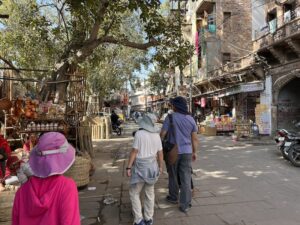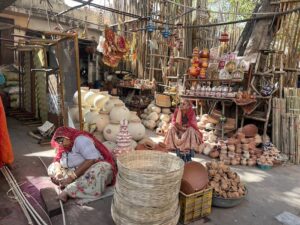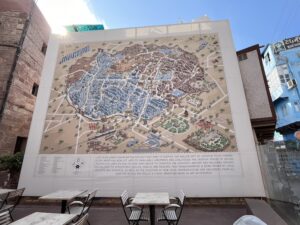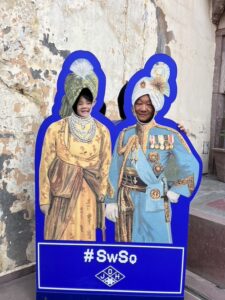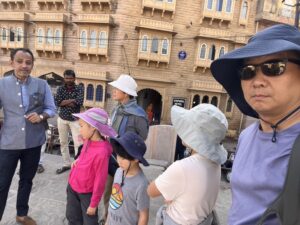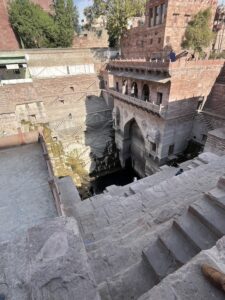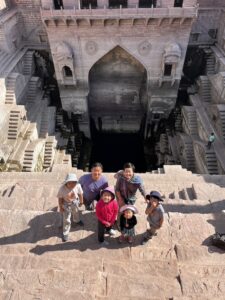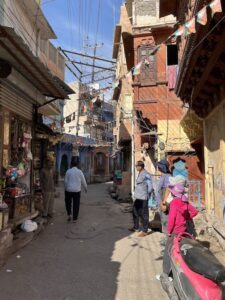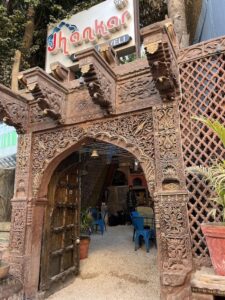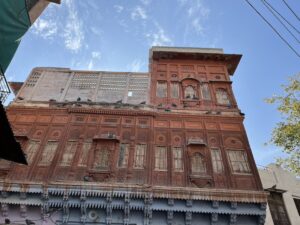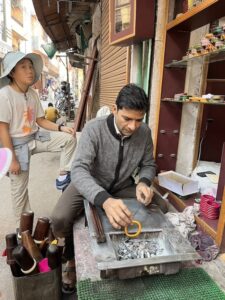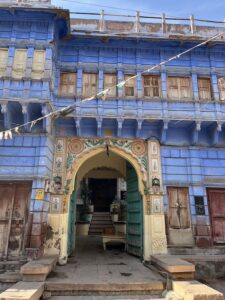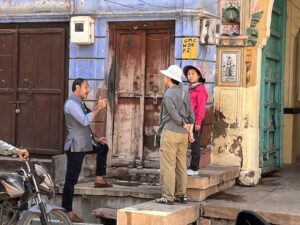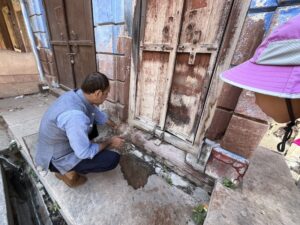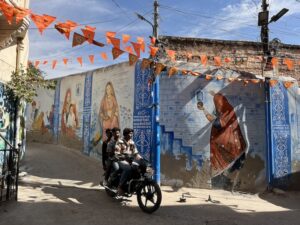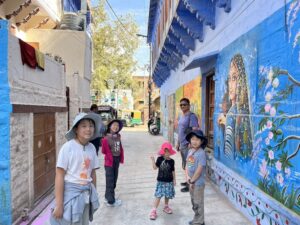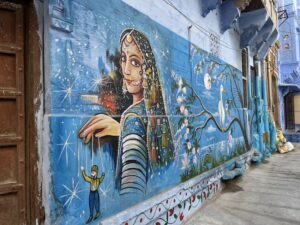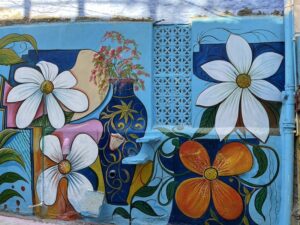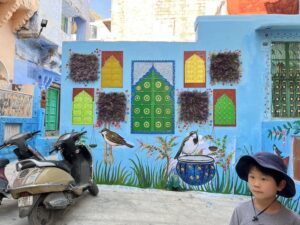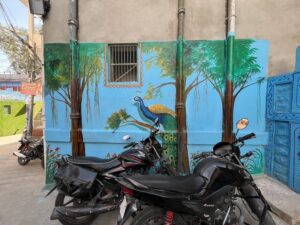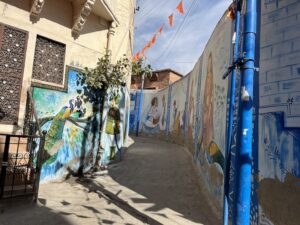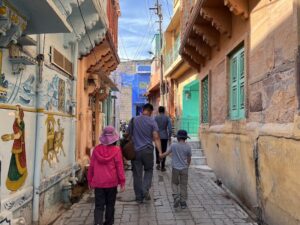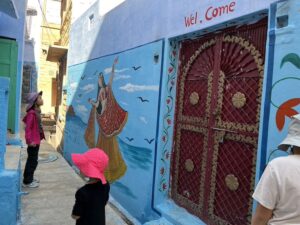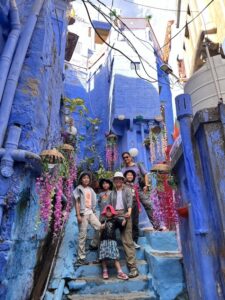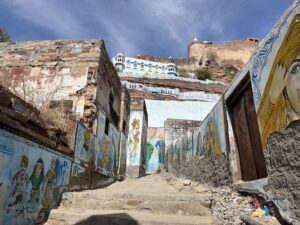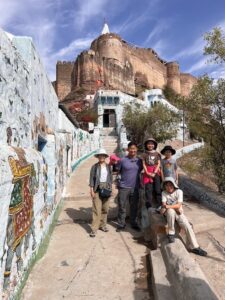Although the kids were not so keen on it, I booked a walking tour of Old Jodhpur. We hadn’t had great experiences with random local guides that we picked up in front of palaces or forts in Jaipur and Udaipur. It’s not that the guides were terrible. They actually did a pretty good job at transmitting information to us, but we seek something more than just information. We are always searching for a feeling of deeper understanding or connection to the place and the people that encounter. Despite past disappointments, I was ready to give it another shot.
The walking tour wasn’t going to be hosted by some random guide. It was hosted by a local resident named Bantu who received a perfect 5-star rating by over 50 customers on TripAdvisor. I had read some of the reviews and “life-changing” and “amazing” were descriptions that came up more than once. I couldn’t wait to meet Bantu.
From messaging with Bantu on Whatsapp, I could already tell that he was a very nice guy. He offered to come and pick us up personally at our house, outside of town, by tuktuk on the morning of the tour. This meant he would need to come with two tuktuks to fit all six of us plus himself. The price of the tour was not expensive and I didn’t want him to be out of pocket. I gave him an “out” and offered to meet him at Ghanta Ghar, the clocktower, but he insisted that we were his guests and it would be his pleasure to come to pick us up.
As good as his word, the next morning, he arrived in front of our house to bring us into town. Bantu was impeccably dressed in a tunic vest over a pressed shirt, black slacks and leather loafers. With his sunglasses on, he could pass for a movie star. I expected Bantu to come with two tuktuks but he was only able to find one. Prior to this, I naively thought 6 passengers was already a tight fit for a standard-size tuktuk so I wasn’t sure how Bantu was planning for us all to fit into the tuktuk. There are larger tuktuks with an extra narrow row of seats facing the main bench, but this was just a standard-size tuktuk with a single bench. To my surprise, it turns out that a small tuktuk can hold at least seven plus the driver. The six of us squeezed into the back, the kids sitting on our laps, and Bantu managed to balance himself on a corner of the driver’s seat with one leg dangling out of the side of the tuktuk, gripping a handlebar with his left hand so he wouldn’t fall out. The driver wasn’t fazed at having to share his space with a stranger. It was just another day in the life.
We arrived at Ghanta Ghar and Bantu told us a little bit about himself and his childhood in Jodhpur. Bantu is an engaging speaker and an expert storyteller. Having spent his entire life here, he has Jodhpur in his blood and running through his veins. We stood under the hot sun beside Ghanta Gar where we were blinded by the sun every time we looked up at the clocktower. Bantu didn’t even break a sweat. He gave us a brief history of Jodhpur with the intensity and passion of someone who has lived there all his life. He wanted us to love Jodhpur just as he did.
We escaped the sun and entered a smaller lane. We passed by some handicraft shops where women were weaving baskets. Bantu seemed to know them and they exchanged a few friendly words as we walked by.
We walked deeper into the maze of streets and found ourselves in front of an impressive development that looked both old and new. Bantu told us that there had been a lot of efforts in recent years to restore and revitalize historic parts of town under the name JDH, Jodhpur Urban Regeneration Project. The main aim of the project was to preserve old havelis and other historical landmarks by turning them into income-generating concepts. With no viable way to generate money, havelis in Jodhpur were falling into disrepair and ruin. JDH’s idea was to clean, renovate and update old havelis and other historical landmarks and turn them into upscale retail, hotel and restaurant concepts that support homegrown brands. This reminded me of the Haveli Dharampura in Delhi (see post on Haveli Dharampura), where we had lunch and flew kites on the rooftop.
Bantu led us through some small streets from which we emerged into a small square and to our surprise, there was a stepwell called Toorji Ka Jhalra Bavdi. We had to walk closer in order to see into it. It wasn’t nearly as big or deep as Chand Baori in Abhaneri village (see post on Chand Baori) but then again, we weren’t in the middle of nowhere like Chand Baori. We were in the middle of Old Jodhpur, the second largest city in Rajasthan.
Toorji Ka Jhalra Bavdi is nearly 300 years old, built in 1740 by a consort of Mahraja Abhay Singh of Jodhpur. It was modeled on a stepwell in Gujarat, the consort’s home kingdom. The stepwell, built using the red sandstone of Jodhpur, is seven stories deep. It was once decorated with carvings of elephants, lions, cows and various gods and deities. The stepwell was used for hundreds of years until water become conveniently accessible from water pipes and taps. Over time, the stepwell fell into disuse and disrepair.
When Bantu was a kid, the Toorji Ka Jhalra Bavdi was a garbage dump, filled with trash, dead animals and human waste inside and around it. It’s hard to imagine that it was once a garbage pit because the stepwell is really deep, nearly 300 feet deep. Nobody paid it any attention other than to complain about the smell. It was only in recent years that the stepwell was cleaned up and restored to its current condition through the JDH Foundation.
When we visited, the stepwell had water inside, but this water is not safe for drinking or household use. I read somewhere that during the hot summer months when temperatures in Jodhpur can reach over 40 degrees, Toorji Ka Jhalra Bavdi is the unofficial swimming pool for kids and youths. The temperature probably wasn’t hot enough for swimming when we were there. There were only a few locals enjoying the view and a couple tourists having a look around.
Before we left, Bantu pointed to a building he used to lease out and operate as a small inn. He had to give up the lease because he didn’t have enough business during Covid. It was now a new trendy hotel with a welcoming cafe.
We walked through some streets where Bantu enthusiastically pointed out intricate carvings on the doors and windows. Indeed, the buildings looked beautiful but they were in desperate need of maintenance and repair.
We stopped to watch an artisan making lakh bangles by hand. We had tried this in Jaipur when we stayed at the Hyatt Regency so the kids watched with great interest to see if they were made the same way here. Almost everything was the same except that this artisan had more equipment to create more designs and tools to help streamline the process.
We entered the oldest part of Jodhpur that gives the city its name, the Blue City. Many of the buildings are painted blue. Bantu pointed out a building that was a movie hall when he was growing up. It had a very beautiful door frame decorated with hand-painted Rajput warriors and beautiful maidens.
We stopped for a rest in front of an old building. This was when Bantu dove into what seemed to be the most important part of the tour. In a serious way, he told us to listen carefully because what he was about to say was quite complicated. I sensed that Bantu felt it was his personal duty to accurately convey the information he was about to share with us – why buildings in Jodhpur were painted blue. He started out by explaining that nobody actually knows with certainty why the people of Old Jodhpur began painting their homes blue and what people talk about nowadays is all their own speculation. He went through the various reasons that could explain the blue wash of the buildings. The most common theory is that the blue color was used to reflect heat to keep the city cool under the blazing heat of the desert sun. Another often heard theory is that blue is associated with the Lord Shiva and the Brahmins (priestly caste) who originally inhabited Jodhpur painted their homes blue to honor the Lord Shiva. Perhaps also related to this theory, in a more earthly way, the Brahmins wanted to identify themselves and their communities as separate and superior to the other lower castes.
Bantu led me across the street and pointed to a part of the building where the exterior wall was crumbling due to termites. The blue color, Bantu explained, came about inadvertently when residents of Jodhpur covered their homes with a mixture of lime and copper sulfate as a deterrent to stubborn termite infestations. Over time, this mixture turned blue. At the time, only Brahmins could afford to cover their homes with copper sulfate, thus it appears that only the Brahmin homes were “painted blue”. Since the Brahmin homes were clustered in one part of the city, the blue color is concentrated in one area.
Once Bantu was satisfied that we had understood his explanation of the blue houses in Jodhpur, we continued on our walking tour. We walked further into the maze of narrow streets and were delighted by all of the murals that adorned the wall and building facades. These murals were commissioned by the city to bring life, beauty and tradition to all the neighborhoods. The paintings fall into two categories – traditional Rajasthani culture and vibrant youth art. Most of the paintings were completed during Covid with the aim of attracting tourists and giving locals a pleasant visual distraction. They have become the backdrop to countless selfies and photos.
We arrived at the “Moroccan Lane”, a famous place for photos decorated in a Moroccan style. There were several other people taking photos and we waited for our turn to take photos too.
We walked through some very narrow lanes where we had to walk by in single-file. The lanes were made intentionally narrow so they would always be shaded from the hot desert sun.
The kids were getting tired and wanted to call an end to the walking tour. It wasn’t that Bantu wasn’t a good guide. Actually, he was a fantastic guide. He had a deep understanding of Jodhpur and showed true expertise in the subject area. He shared many personal stories with us about growing up in Jodhpur and the changes he has personally witnessed. He engaged us in an ongoing dialogue that absolutely kept me interested. He was everything that the reviews promised – passionate, insightful and authentic. But sometimes kids can be finicky. Maybe it was getting a little warm walking under the sun or maybe they were hungry or maybe they just weren’t that interested.
Before ending the tour, Bantu encouraged us to just make it up Pachetia Hill where we could see a 360-degree view of the city with Mehrangarh Fort in the background. How could we refuse?
The path was less than ideal with dog poo every few steps. Even with the heat and the dog poo, it was still a lovely walk. By the time we made it up the hill, we were panting and sweating and the kids were not very pleased. Bantu never even broke a sweat.
As promised, the view was breathtaking. It was from this vantage point that we discovered that Jodhpur is not actually very blue. Most of the buildings are white or beige. There are even a few misfits painted in a preposterous pink. By our estimation, only about 10-15% of the buildings in Old Jodhpur are actually painted blue.
We took a final photo in front of the Maa Jwalamukhi Devi Temple with the Fort in the background. From the kids’ body language, I knew it was time to say goodbye to Bantu. We told Bantu that we had a lunch appointment nearby. He insisted to dropping us off by tuktuk in front of the restaurant.
Sometime after, I happened to come across the itinerary for Bantu’s walking tour that he sent to me on Whatsapp and I realized that because we cut the tour short, we missed seeing a few other sites. One was Navchowkiya, a 15th century colony, and the others were the twin lakes, Ranisar and Padamsar.
Traveling with kids is an exercise in compromise. We get to explore and discover together, but sometimes not at the pace or to the depth that we wish. I don’t expect to see every site in every place we travel to. I am happy to save some for another day. But it can be frustrating when we have to pass up the chance to see something because the kids are tired, grumpy, hungry or impatient.
Each of the kids has their unique needs, limitations, preferences and interests and so do we, their parents. In planning, we make every effort to find sites, attractions and activities that the kids will enjoy, even if it isn’t at the top of our list. We always make time for malls and toy stores. Even if we don’t intend to buy anything, the kids enjoy mall culture, just walking around and browsing at things. Each of the kids has their own hobbies and interests that we try to encourage and nurture during our travels. RY is interested in history and cooking while AY is interested in the supernatural and art. DY is interested in the natural world and weapons while EY is interested in fairytales and stories.
For me, I love visiting museums and historical sites where I can learn about the people, events and history of a place. Sometimes the kids enjoy it, but sometimes they just find it dull. I don’t expect them to love it, but I do expect them to allow me to enjoy it and I hope that over time, they can learn to enjoy it too. I do the same for them.
That is the nature of compromise. For the sake of the family, no one individual can get everything that they want. We all have to pick and choose what is important to us and what we are willing or able to give to others. Since we started traveling, we’ve all learned how to be more considerate and patient so everybody has a chance to indulge in their interests. We continue to work at being better every day.
Author
-

Song is the mother of four children. She and her family have stepped away from it all and in September 2023, began traveling the world while homeschooling. Song is an ABC (American born Chinese) and has an undergraduate degree from Cornell and an MBA from Harvard. She is an entrepreneur and an educator. Her hobbies include learning, traveling, reading, cooking and baking, and being with children.



